Click on images to enlarge
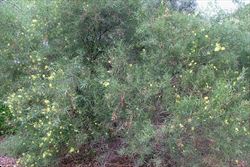
habit (Photo: Sheldon Navie)
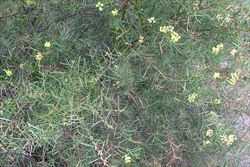
habit (Photo: Sheldon Navie)
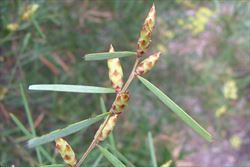
young flower clusters enclosed in overlapping brown-tipped bracts (Photo: Sheldon Navie)
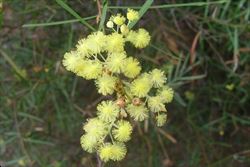
pale yellow flower clusters (Photo: Sheldon Navie)
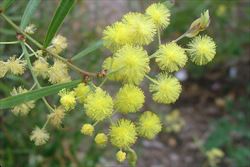
close-up of the globular flower clusters (Photo: Sheldon Navie)

immature fruit (Photo: Bruce Maslin)
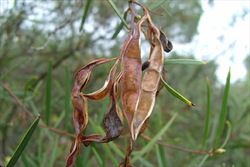
mature fruit (Photo: Sheldon Navie)
Scientific Name
Acacia iteaphylla F. Muell. ex Benth.
Synonyms
Acacia iteaphylla F.Muell. ex Benth. var. iteaphyllaRacosperma iteaphyllum (F.Muell. ex Benth.) Pedley
Family
Fabaceae: sub-family Mimosoideae (New South Wales)Leguminosae (South Australia)Mimosaceae (Queensland, the ACT, Victoria, Tasmania, Western Australia and the Northern Territory)
Common Names
Flinders Range wattle, Port Lincoln wattle, willow-leaved wattle, winter wattle
Origin
This natural distribution of this species is restricted to some parts of southern South Australia. It occurs naturally in the Flinders Ranges, across to the Gawler Ranges, and on the Eyre Peninsula.
Cultivation
Flinders Range wattle (Acacia iteaphylla) has been widely cultivated in the southern parts of Australia. It is still popular as an ornamental species, with many forms being cultivated. Some of these have very pendulous branchlets, while others are more upright in nature. The most well-known cultivar of this species is a low-growing form called Acacia 'Parsons Cascade'. It differs from the typical form by having low arching, slightly pendulous, branches and grows up to 0.5 m tall and 4 m wide.
Naturalised Distribution
Naturalised beyond its native range in some parts of south-eastern and southern South Australia. Also naturalised in some parts of New South Wales, in the coastal and sub-coastal districts of south-western Western Australia and in the central and western parts of Victoria. There are also reports that it has become naturalised in Tasmania and the ACT, but these have not been verified by herbaria.
Habitat
In its natural environment, in semi-arid and temperate South Australia, Flinders Range wattle (Acacia iteaphylla) grows mainly among rocky outcrops on hillsides or along rocky creeks in valleys.
In Western Australia it grows mainly in Jarrah woodlands on sandy soils.
Habit
A bushy, spreading, shrub or small upright (i.e. erect) tree growing 2-5 m tall.
Distinguishing Features
- a large shrub or small tree with alternately arranged simple 'leaves'.
- its long and narrow, silvery, bluish-green 'leaves' have a single prominent vein running lengthwise.
- its yellow or pale yellow flowers are arranged into small globular clusters that are borne in short compound clusters in the 'leaf' forks.
- young flowering branches are initially enclosed in several overlapping brown-tipped bracts.
- its elongated and flattened pods (5-13 cm long and 6-12 mm wide) are slightly constricted between each of the seeds.
Stems and Leaves
Young plants have greenish coloured bark, but this eventually turns brown in colour as the plant matures. Younger branches are hairless (i.e. glabrous) and become somewhat angled towards their tips. They are sometimes drooping in nature (i.e. pendulous) and often covered in a whitish, powdery coating (i.e. they are pruinose).
The 'leaves' of this plant are actually flattened and widened leaf stalks (i.e. petioles), and not leaves in the true sense of the word. These modified leaf stalks are called phyllodes, but serve the same function as a regular leaf. On very young plants, partially formed phyllodes can be seen which bear twice-compound (i.e. bipinnate) leaves at their tips. As the seedling grows, each new 'leaf' has phyllodes that are more fully formed and the leaves at their tips eventually vanish altogether. The alternately arranged phyllodes are very narrow to elongated in shape (i.e. linear to narrowly elliptic) and silvery bluish-green in colour. These phyllodes (5-14 cm long and 2.5-8 mm wide) are straight and held almost at right angles to the stem, with a tiny curved or straight point (1-2 mm long) at their tips (i.e. a mucronate apex). They are also hairless (i.e. glabrous) and relatively thin, with a rather prominent midvein that runs down most of their length. The other veins are relatively obscure and where the phyllode joins to the stem there is a short thickened structure (i.e. a pulvinus) 1-2 mm long. An inconspicuous raised structure (i.e. gland) is usually present on the edge of the phyllode 1-10 mm above where it joins to the pulvinus.
Flowers and Fruit
The small yellow or pale yellow flowers are stalkless (i.e. sessile) and densely arranged into small globular clusters (5-8 mm across), each containing numerous (12-17) flowers. The individual flowers each have five relatively inconspicuous petals and sepals and numerous conspicuous stamens that give them a fluffy appearance. The globular flower clusters are borne on short slender stalks (6-10 mm long) and 8-16 of them are alternately arranged along a short branch (2-4 cm long) emanating from the forks (i.e. axils) of the leaves (i.e. in axillary racemes). These flowering branches (i.e. racemes) are hairless (i.e .glabrous) and usually covered in a whitish powdery substance (i.e. they are pruinose). When young, the buds of these flowering branches are enclosed by several distinctive overlapping (i.e. imbricate) pale brown-tipped bracts (about 5 mm long). Flowering occurs during autumn and winter (i.e. from April to September).
The fruit is an elongated an flattened pod (5-13 cm long and 6-12 mm wide) that is either straight or slightly curved. These pods are hairless (i.e. glabrous), slightly constricted between each of the seeds, and leathery in appearance. They are initially bluish-green in colour, often covered with a whitish powdery substance (i.e. pruinose), and turn brown as they mature. The seeds are oblong to oval (i.e. elliptic) in shape (5-6.5 mm long) and dark brown to black in colour. They have a rather dull appearance and a narrow fleshy structure (i.e. aril) attached to one end.
Reproduction and Dispersal
Flinders Range wattle (Acacia iteaphylla) produces numerous hard seeds, that are probably long-lived like those of other acacias. These seeds are probably spread by animals (e.g. birds and ants). They may also be dispersed in dumped garden waste and contaminated soil.
Environmental Impact
This Australian wattle is a significant environmental weed outside its native range, and is particularly troublesome in parts of South Australia where it is not native. It is listed as a common environmental weed in the Adelaide region and in the Mount Lofty Ranges, where it is still widely cultivated. This is largely because Flinders Range wattle (Acacia iteaphylla) is native to nearby parts of South Australia and has therefore been widely planted and recommended as a 'native' plant. It is listed as one of the six most common introduced wattle species growing on Bush For Life revegetation sites in south-eastern South Australia and is an introduced weed in numerous parks and reserves in this area (e.g. in Ashby Reserve, Naracoorte Caves Conservation Park, Tuttangga Park, Mount Remarkable National Park, Belair Reserve and Scott Creek Conservation Park).
In south-western Western Australia, Flinders Range wattle (Acacia iteaphylla) is also becoming a woody environmental weed of some concern. It is found throughout the Perth region and has become quite a problem in the older areas of the city, where it was quite often planted as a hedge or windbreak. The Swan Catchment Council considers it to be a serious environmental weed, and it is one of the two most common species of weedy wattles in the City of Wanneroo, in north-western Perth. It is also regarded as a weed in the Shire of Mundaring in the Darling Ranges.
Flinders Range wattle (Acacia iteaphylla) is also having an impact as an environmental weed in Victoria. Most records of this species in this state come from the area to the north-east of Melbourne, but it is also listed as a common invasive tree species in the North Central Region of Victoria and is one of the main weed species along Waurn Ponds Creek in Geelong, south-west of Melbourne.
This species is generally of less concern elsewhere, though it has been reported growing in conservation areas in New South Wales (e.g. in Jackson Park in the Blue Mountains) and the ACT (e.g. in the Bruce Ridge Nature Park). It has also been described as a potential environmental weed in the ACT and a moderately important threat to the east coast region of Tasmania.
Legislation
Flinders Range wattle (Acacia iteaphylla) is not declared or considered noxious by any state or territory government in Australia.
Management
For information on the management of this species see the following resources:
- the Woody Weeds Information Pamphlet on the Environmental Weeds Action Network (EWAN) website at http://members.iinet.net.au/~ewan/.
Similar Species
Flinders Range wattle (Acacia iteaphylla) is very similar to sweet-scented wattle (Acacia suaveolens), which also has its flowering branch buds enclosed in several overlapping bracts. However, sweet-scented wattle (Acacia suaveolens) is a slender sparingly-branched shrub with flattened or strongly angled younger branches. Its globular flower clusters are also borne on shorter stalks (3-5 mm long) and its fruit are shorter and wider (i.e. 2-5 cm long and 10-20 mm wide) that those of Flinders Range wattle (Acacia iteaphylla).
Note: For a more in-depth key to distinguish between all of the wattles (Acacia spp.) present in Australia, see the Wattle: Acacias of Australia CD-ROM or Flora of Australia, Volumes 11A and 11B.

